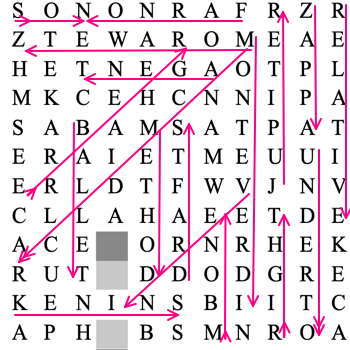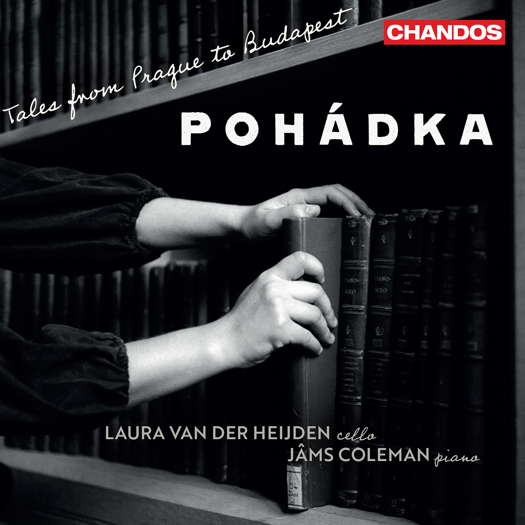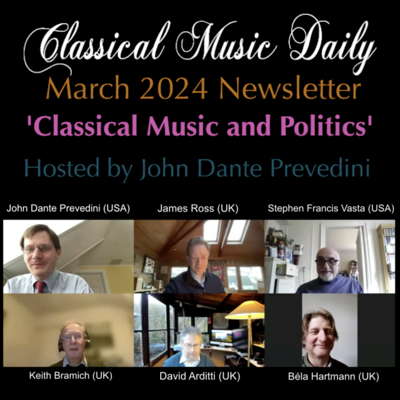 WORD SEARCH: Can you solve Allan Rae's classical music word search puzzles? We're currently publishing one per month.
WORD SEARCH: Can you solve Allan Rae's classical music word search puzzles? We're currently publishing one per month.

Lovely and Very Effective
Music from Central and Eastern Europe for cello and piano, recommended by GEOFF PEARCE
'... very gifted, skilful and inspired ...'
This new Chandos recording contains music that is familiar, some of it being transcribed by the cellist, together with less well known items. The featured young artists, cellist Laura van der Heijden and pianist Jâms Coleman, have emerged within the last ten years and are technically assured and players of musical sensitivity. I hope that this debut album generates a lot of interest in both the music being performed and these inspirational performers.
The first work is Pohádka, a Czech word meaning a fairy tale, by Leoš Janáček. This three-movement work, a meditation on several aspects of an 1832 epic poem by Vasili Zhukovsy, was written initially in 1910 then revised several times. The first movement, Con moto, is typical of Janáček's writing at the time. The melodic lines are expansive and warm. During the introduction, the piano has most of the melodic interest and there are pizzicato cello interjections. Then the cello plays a more prominent role, singing gloriously over the delicate piano accompaniment. This gives way to some more impassioned moments, but the movement closes gently. I am reminded at times of Janáček's opera Jenůfa, written some years earlier.
Listen — Janáček: Con moto (Pohádka)
(track 1, 3:22-4:06) ℗ 2022 Chandos Records Ltd :
The second movement also opens with piano and pizzicato cello, and the mood is rather playful and rhapsodic. This gives way to a rather wistful section that becomes more impassioned and anguished as it progresses, but the whimsical section returns and then the music ends calmly.
Listen — Janáček: Con moto - Adagio (Pohádka)
(track 2, 2:38-3:22) ℗ 2022 Chandos Records Ltd :
The last movement is the shortest and is good humoured and dance-like.
Zoltán Kodály's two-movement Cello Sonata, Op 4 (1909-1910) was dedicated to his wife. It owes much to the exposure to Hungarian folk music that Kodály and his friend Béla Bartók were researching and collecting at around that time, and also to Debussy's Pelleas et Melisande, which Kodály had experienced on a 1907 visit to Paris. The broad and slowish first movement, entitled 'Fantasia', owes much to both these influences.
Listen — Kodály: Fantasia (Cello Sonata, Op 4)
(track 4, 6:25-7:13) ℗ 2022 Chandos Records Ltd :
The second movement is a spirited dance with strong rhythms, rapid changes of dynamics and florid passages, managed here with consummate ease. This vigorous nature is not maintained to the end, though, and the movement finishes in a similar character to the first movement.
Listen — Kodály: Allegro con spirito (Cello Sonata, Op 4)
(track 5, 2:51-3:33) ℗ 2022 Chandos Records Ltd :
I love the artists' collaboration in a beautiful transcription of the well-known Songs my mother taught me by Antonín Dvořák. They are very sensitive to the nature of the song and the balance between them, and this sums up the quality of the whole disc.
Listen — Dvořák: Als die alte Mutter (Songs my mother taught me)
(track 6, 0:00-0:44) ℗ 2022 Chandos Records Ltd :
There is also a lovely and very effective transcription of the Kodály song, Mért is mondod, hogy nem szeretsz (Why are you saying that you do not love me?), Op Post No 1.
This is followed by the very brief and evocative folk song Slender is a silk thread, transcribed from Kodály's Op 1.
The musician András Mihály (1917-1993) was active in many different areas. His little known and rather taut Mouvement was written for Kodály's eightieth birthday in 1963. This is a demanding work for both artists, and Laura van der Heijden and Jâms Coleman are certainly up to the challenge here, giving a thrilling performance.
Listen — András Mihály: Mouvement
(track 9, 4:17-5:04) ℗ 2022 Chandos Records Ltd :
Navždy (Forever), by Vítězslava Kaprálová (1915-1940), taken from her Opus 12 set of three songs, has been transcribed by Laura van der Heijden.
Listen — Vítězslava Kaprálová: Navždy
(track 10, 1:13-1:54) ℗ 2022 Chandos Records Ltd :
Kodály's 1909 Sonatina has strong links to the two-movement Cello Sonata which appeared earlier on this album. Kodály often stated that he did want to write a third movement for the Sonata, but even though this Sonatina was written around the same time and was intended to perhaps become that third movement, it was never included and remains as a stand-alone work.
The last work here is Laura van der Heijden's transcription of Janáček's Violin Sonata, written in 1914-15 and further revised later. This a much loved work and the transcription is faithful to the original, with some parts being transposed down an octave. This sonata is typical of the second period of Janáček's life and was written with the background of the Russian military advance at the opening of World War I and the hope of Janáček and his Moravian compatriots that the yoke of the Austro-Hungarian Empire might at long last be removed from his homeland. This is a substantial work and has four varied movements.
Listen — Janáček: Adagio (Sonata JW VII/7)
(track 15, 2:29-3:19) ℗ 2022 Chandos Records Ltd :
I love this disc very much and recommend it highly, especially if you are, as I am, a lover of Central and Eastern European music. The programme notes are comprehensive, the two artists very gifted, skilful and inspired, and the recording quality impressive.
Copyright © 22 January 2022
Geoff Pearce,
Sydney, Australia

CD INFORMATION: POHÁDKA - TALES FROM PRAGUE TO BUDAPEST



